MEMORIES from the 4th Latin American School of
High-Energy Physics
Viña del Mar, Chile, 18 February - 3 March, 2007
The fourth School in the new series of Latin American Schools of High-Energy Physics took place in Viña del Mar, located on the Pacific coast in Chile, close to Valparaiso, from 18 February to 3 March 2007. It was organized by CERN with the support of the Universidad Tecnica Federico Santa Maria, Valparaiso and of CONICYT (Comision Nacional de Investigacion Cientifica y Technologica). Professor Claudio Dib from Universidad Tecnica Federico Santa Maria, Valparaiso, acted as local director for the School.
At the opening cocktail we were acccompanied by the Rector of UTFSM, Dr. José Rodríguez Pérez, and the Physics Dept. chairman, Gastón Agüero. At the closing dinner we had as a guest Mr. Patricio Hales, congressman of the Republic of Chile.
Forty-six students coming from fifteen different countries attended the School, and according to the tradition of the School the students shared twin rooms mixing nationalities and in particular Europeans together with Latin Americans.

Castillo Wulff
The Poster announcing the School shows the Castillo Wulff. This two-storey building with attached tower that was built in 1880 is known as Wulff Castle. Nowadays the "Castle" belongs to the Municipality of Viña del Mar and houses the Maritime Museum, the "Museo Cultura del Mar".
Forty-six students coming from fifteen different countries attended the School. According to the tradition of the School the students shared twin rooms mixing nationalities and in particular Europeans together with Latin Americans.
The School was hosted in the beautiful Convention Center "Conference Town" that has its own Hotel. Conference Town's gastronomic restaurant "Pindal" is famous in Viña area and the food was excellent and served by a very professional team.Thanks to the nice weather that was always sunny but never really warm, coffee breaks were always served in the garden.
All the lectures were given in the main lecture hall where the students also displayed their work in the form of posters on a special evening session the first week. The posters were pinned on the walls and were kept up until the last day.
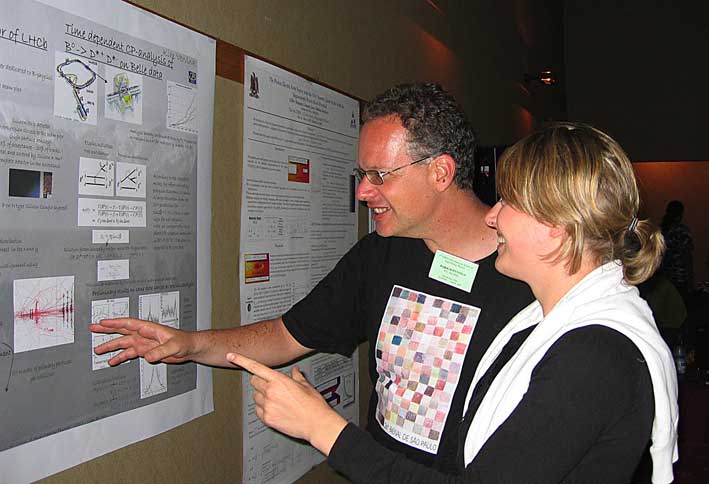
Rogerio and Kim

Poster Session
On Tuesday, 20 February we enjoyed a special lecture by Francisco Mena on Baño Nuevo Cave and the peopling of the Americas"
During the free time the students had the possibility of swimming in the pool, playing football on the green, strolling in the eucalyptus forest surrounding the Hotel or going to Reñaca beach, one of Chile's premier beach resorts, which was within walking distance.
The school also had a few organized social activities.
On the first day of the school a welcome drink was offered by the Southern Sun Wine Group. (http://www.southernsunwine.com). The company also donated the wine for the closing banquet, and on both occasions this was accompanied by lessons in wine tasting by Ms. Carolina Rivera from SSWG.
On Wednesday, 21 February, an excursion was offered to the "Jardin Botanico Nacional" in Viña del Mar, an oasis of vegetation, covering an area of 40 hectares with more than 800 species of flora. (http://www.jardin-botanico.cl/). Our guide through the beautiful garden was the botanist Maria Teresa Concha. Originally commissioned by the nitrate baron, Pascual Baburizza, and created by the French landscape gardener, George Dubois, the park was donated to the Nitrate and Iodine Company so as to assure its permanence. This park serves both an educational and scientific purpose, and is an excellent place to go walking, thanks to its stony paths, ponds and woodlands. At our arrival we were guided through the Cactario, a restricted area with a unique cactus collection.
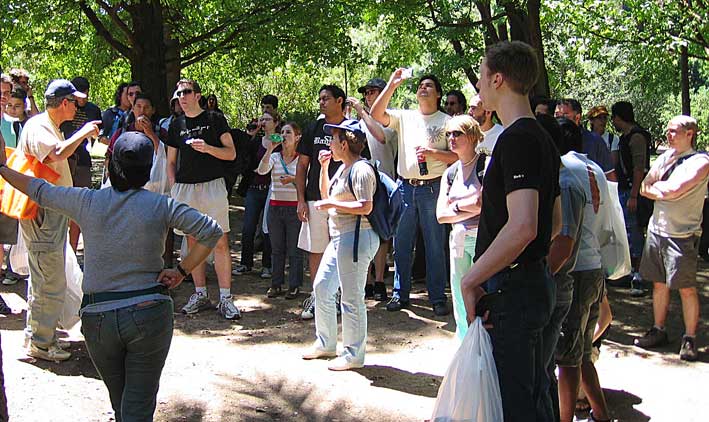
Claudio guiding in the Botanic Garden
After eating our picnic we found a nice place to rest in the park and then visited the French Garden, the Lagoon, the Breeding ground, the collections of the Oceanic Islands, as well as the great meadows. Some students played soccer and Enrico Nardi distinguished himself playing a perfect game: "memories of early days when playing in a football team" he said. A few others, feeling wild, took advantage of the facilities of the Canopy, a new sports adventure that offers a unique activity and an ecological experience at the same time. It is reached by trees from where beautiful landscapes can be seen, and which otherwise would be hard to spot from the ground. In the trees there were wooden platforms where the wild and curious sportsman can rest, contemplate the nature and continue the route that in each section presents new challenges.
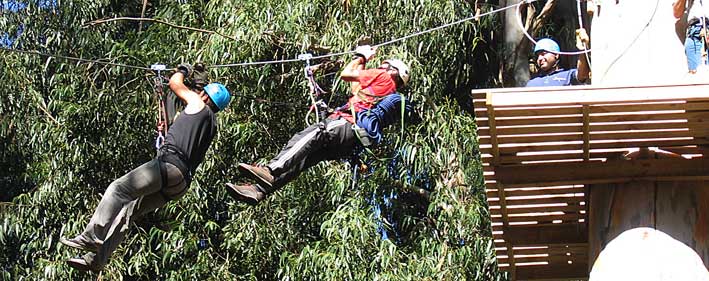
Rescue Operation
Another full day excursion was to Isla Negra with the visit of Pablo Neruda's house. Isla Negra, which is not an island at all, lies about 2 hours from Viña.The words of Pablo Neruda, a Nobel Prize winning Chilean poet, a one time Senator, a Communist, an exile, and the biggest celebrity of his time are recognized today as they ever were. Pablo Neruda had several houses but the one on the Isla Negra was his favorite. Each house resembles the boat and has touches of the sea and each setting combines many natural elements such as mountains or ocean. The main dining area at Isla Negra is filled with huge wooden mastheads taken from one time seafaring vessels featuring maidens with long flowing hair.
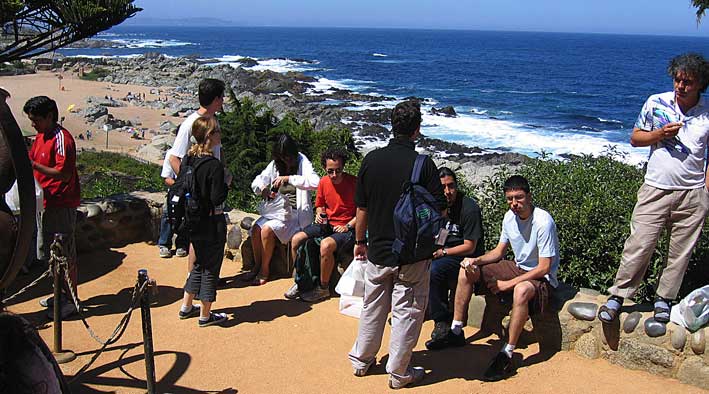
View from Neruda's garden
The house was purchased from a Spanish ship captain in 1938 who owned much of the land along the coast. Not long after buying it, Neruda and the Catalan architect Germán Rodríguez Arias began to add to the house a tower, a chimney and a large window facing the sea. A roof was also added which was meant to remind the poet of his childhood in Temuco. It is decorated with Neruda's fantastic collection of strange objects (butterflies, sea shells, paintings, lamps, books) and a large stone fireplace adorned with stones such as lapis lazuli. The poet's tomb lies in the garden facing the ocean.
On our way back we stopped in the Casablanca Valley known for of its climate and ground conditions to be an excellent land for vine-stocks, not only for wines like Chardonnay and Sauvignon Blanc but also for red wines. Our excursion included a visit to one of the most famous vineyards: Viña Mar (http://www.vinamar.cl/). Located in one of the best sites, the vineyards benefit from their permanent exposure to the sun and light winds coming from the seashore during spring and summer evenings, thus providing perfect conditions for the growing of its fruits and production of fine wines. The main building is a replica of an emblematic building of Viña del Mar, the Vergara's family Palace. Viticulturists told us about their success with new varieties and methods, and gleaming new wineries showed off their latest bottling. The specialty here is fine white wines, but also Chile’s most traditional Cabernet Sauvignon is proudly served. Our visit to Vina Mar winery included a pleasant and interesting wine tasting.
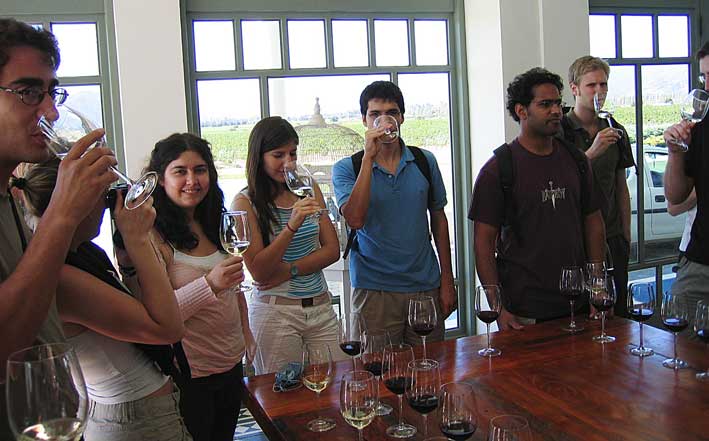
Wine Tasting
After lunch we continued to Valparaiso, a famous harbor with multicoloured houses covering the hills and with numerous funiculars, and declared a World Heritage site in 2003. We went to the "Puerto Turistico" and enjoyed a short boat trip around the harbour. In the bay, the attraction is a mooring buoy on which there are always a few enormous sea wolves basking in the sun, and the boat with the students packed like canned sardines used it as a roundabout.
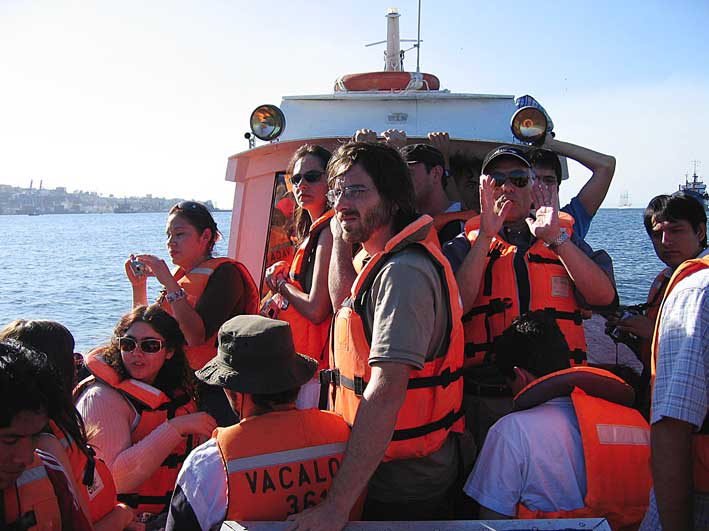
High Density Event
A new event was introduced at this School. Following a proposal from Rogerio Rosenfeld each discussion group decided to work on an interesting subject which was not covered at the school with one or several students from each group presenting the group's work at a special student presentation the last afternoon of the school. This proposal was highly appreciated by all the school participants, and the final student presentation was a great success. We believe that this will be followed up at future schools.
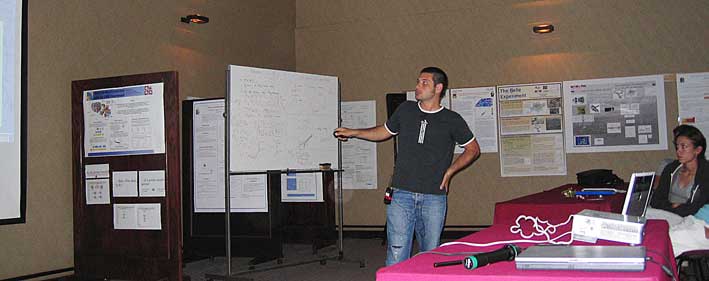
Gabriel presenting the work of his discussion group
HAPPY ENDING
On the last evening of the School the traditional banquet was organized with delicious and abundant food and good wines. Claudio Dib, the local director of the School, and Egil Lillestol, Director of the CERN Schools, thanked the hotel staff, lecturers, discussion leaders and last but not least the students for a very successful School.
And then the students took over
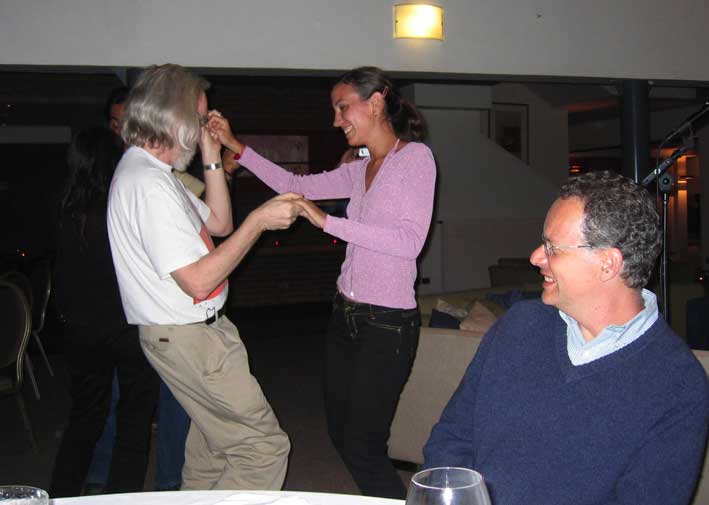
Salsa Lesson